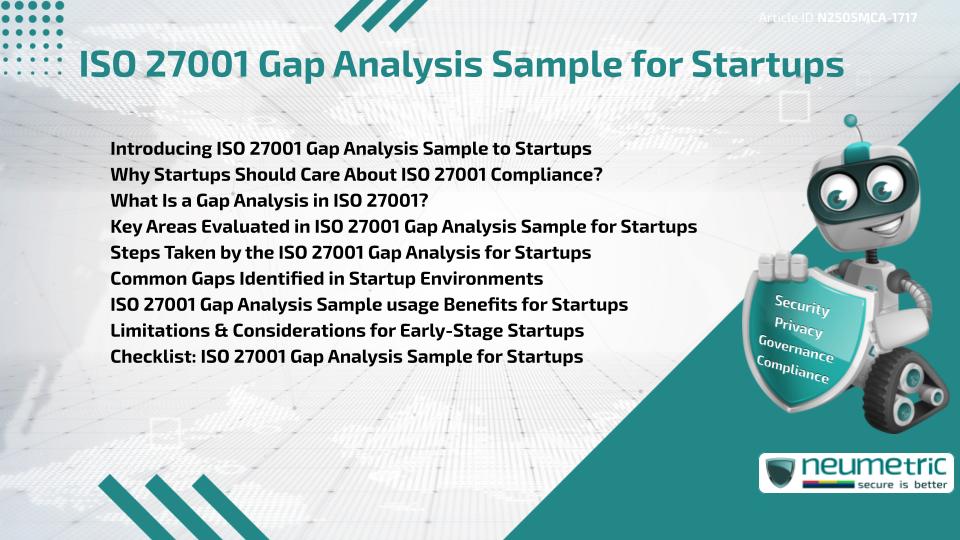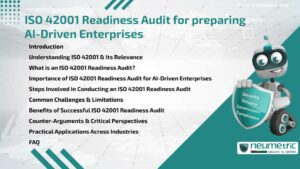Table of Contents
ToggleIntroducing ISO 27001 Gap Analysis Sample to Startups
Startups generally move quickly, focused on innovation & growth. But with this agility comes a challenge: maintaining strong Information Security. For startups looking to build Customer Trust or scale into regulated markets, aligning with ISO 27001 is a smart move. One of the most effective ways to begin is by conducting a Gap Analysis.
An ISO 27001 Gap Analysis sample for startups is a structured approach for assessing current practices against the standard’s requirements. It helps teams to understand where they stand & what steps they need to take for improving their security posture.
Why Startups Should Care About ISO 27001 Compliance?
When complying with ISO 27001, the global Standard for Information Security Management Systems [ISMS], signifies maturity & reliability. For startups, especially those offering software-as-a-service or managing User data, ISO 27001 Compliance can:
- Support growth into enterprise markets
- Build Customer & investor confidence
- Prepare for audits & Certifications
- Reduce the Risk of breaches & fines
An ISO 27001 Gap Analysis sample for startups makes these goals more achievable by breaking down the Standard into manageable steps.
What Is a Gap Analysis in ISO 27001?
A Gap Analysis is used as a comparison of the existing Information Security Controls against the requirements of ISO 27001. It identifies which controls you already meet & which ones need improvement.
Using an ISO 27001 Gap Analysis sample for startups, you can assess key areas like Risk Assessment, asset management, Access Control & Incident Response. This process highlights gaps between the existing practice & what the Standard expects.
Key Areas Evaluated in ISO 27001 Gap Analysis Sample for Startups
A typical sample includes evaluation of the following:
- Context of the Organisation: Better grasp of internal & external issues
- Leadership & Roles: Defined responsibilities & security commitment
- Risk Assessment Process: Identification & treatment of Risks
- Asset Inventory: Documenting & categorising key information assets
- Access Controls: Managing User permissions & authentication
- Business Continuity & Incident Management: Preparedness for disruptions
- Compliance Requirements: Addressing laws & regulatory expectations
These components form the core of an ISO 27001 Gap Analysis sample for startups & guide what actions are required next.
Steps Taken by the ISO 27001 Gap Analysis for Startups
- Choose a Gap Analysis Template
Use a publicly available ISO 27001 Gap Analysis checklist or build your own based on Annex A controls. - Assess Current Controls
Evaluate what Security Policies, processes & tools you already have in place. - Compare Against ISO 27001 Requirements
Identify which clauses or controls are missing or insufficient. - Prioritise Gaps
Rank gaps based on Risk exposure, regulatory urgency or ease of remediation. - Document Findings & Plan Next Steps
Use the output to build a roadmap for becoming ISO 27001 compliant.
A good ISO 27001 Gap Analysis sample for startups will include templates, Risk scoring guidance & action planning sections.
Common Gaps Identified in Startup Environments
Startups often share a few common challenges:
- Lack of formal Policies or procedures
- Weak Access Control or shared credentials
- No documented Risk Assessments
- Inadequate Incident Response planning
- Missing roles for Information Security
An ISO 27001 Gap Analysis sample for startups can surface these issues early before they become Compliance or reputational problems.
ISO 27001 Gap Analysis Sample usage Benefits for Startups
Using a structured sample saves time by reducing complexity. Benefits include:
- A clear understanding of current security posture
- Faster preparation for ISO 27001 audits
- Confidence during external Stakeholder reviews
- Reduced Risk from overlooked Vulnerabilities
- Step-by-step improvement roadmap
The ISO 27001 Gap Analysis sample for startups gives a practical starting point for teams with limited security expertise.
Limitations & Considerations for Early-Stage Startups
While useful, a Gap Analysis sample has limitations:
- It may not reflect your unique business context unless customised
- Some controls may not apply or may require minimal adaptation
- External help may be needed to interpret certain requirements
- Resource constraints may delay implementation despite clear findings
Despite these issues, an ISO 27001 Gap Analysis sample for startups remains a valuable tool, especially when used as part of a phased Compliance journey.
Checklist: ISO 27001 Gap Analysis Sample for Startups
Here’s a simplified checklist to guide your analysis:
- Have roles & responsibilities for security been assigned?
- Are key assets identified & documented?
- Has a Risk Assessment been performed & updated?
- Do you have Policies for Access Control & Incident Response?
- Are your staff trained on security procedures?
- Is security included in your vendor management processes?
- Do you review Compliance obligations regularly?
This checklist, found in many ISO 27001 Gap Analysis samples for startups documents, helps to track their progress & plan for what’s next.
Takeaways
- ISO 27001 is a valuable Standard for startups that want to improve their security & earn trust.
- A Gap Analysis helps to assess the current practices against the standard’s requirements.
- An ISO 27001 Gap Analysis sample used by the startups makes the process simple.
- Common startup gaps usually consist of weak documentation & informal controls.
- Even with restrictions, a Gap Analysis is an important early step towards Compliance.
FAQ
What does an ISO 27001 Gap Analysis sample mean for startups?
It is a template or checklist used to assess a startup’s current Security Controls against the ISO 27001 Standard to identify areas for improvement.
Why should startups conduct an ISO 27001 Gap Analysis?
It helps them understand where they fall short on security practices & how to align with ISO 27001 without overwhelming effort.
Is ISO 27001 necessary for early-stage startups?
While not mandatory, it is highly beneficial for building credibility & protecting Sensitive Data from the beginning.
How long does a Gap Analysis usually take?
For startups, a focused ISO 27001 Gap Analysis can take anywhere from one (1) to three (3) weeks depending on the company’s size & preparedness.
Can we perform the Gap Analysis ourselves?
Yes, especially if using a clear ISO 27001 Gap Analysis sample for startups, though external guidance can add clarity & speed.
What should we do after identifying gaps?
Create a roadmap to address the findings, prioritise by Risk & start developing the missing Policies or controls.
Are there free templates available?
Yes. You can find Gap Analysis templates from non-commercial sources & ISO forums.
Need help?
Neumetric provides organisations the necessary help to achieve their Cybersecurity, Compliance, Governance, Privacy, Certifications & Pentesting goals.
Organisations & Businesses, specifically those which provide SaaS & AI Solutions, usually need a Cybersecurity Partner for meeting & maintaining the ongoing Security & Privacy needs & requirements of their Clients & Customers.
SOC 2, ISO 27001, ISO 42001, NIST, HIPAA, HECVAT, EU GDPR are some of the Frameworks that are served by Fusion – a centralised, automated, AI-enabled SaaS Solution created & managed by Neumetric.
Reach out to us!





